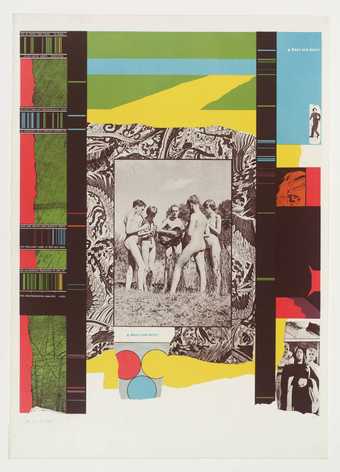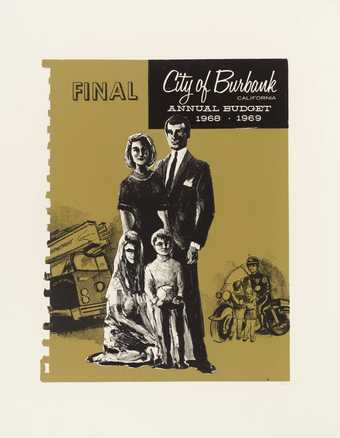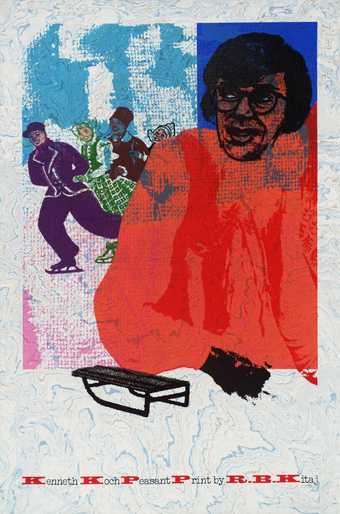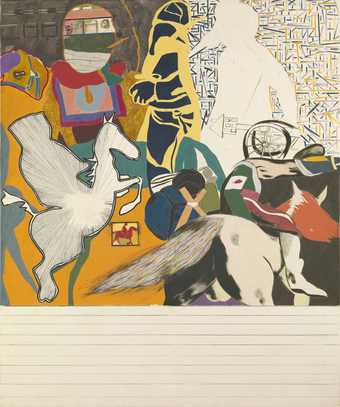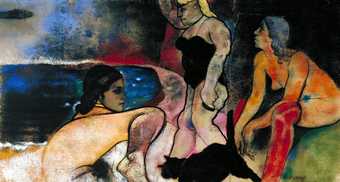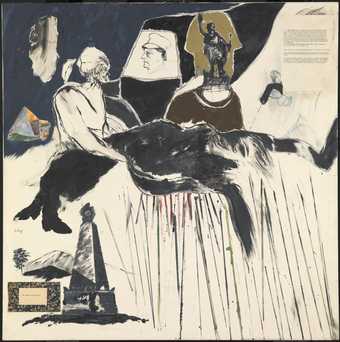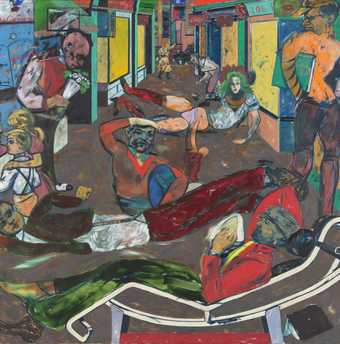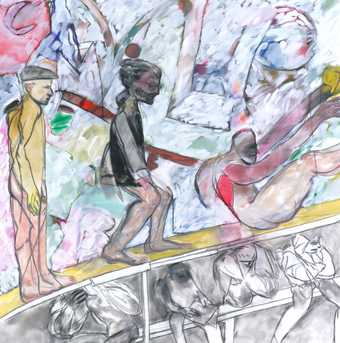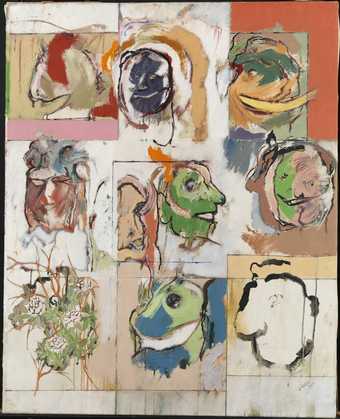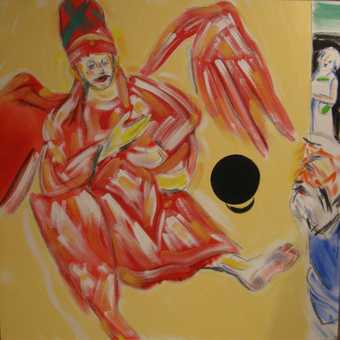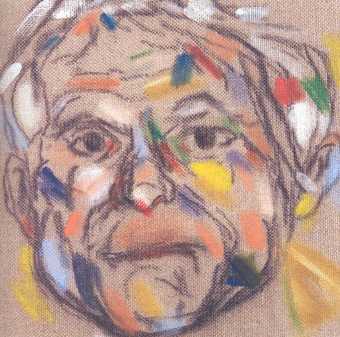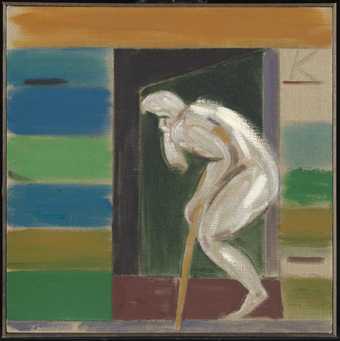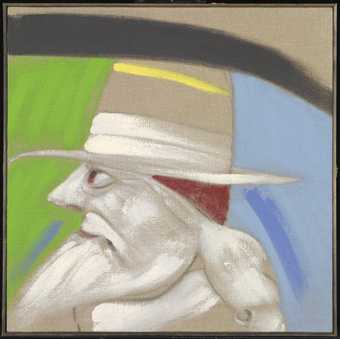
Not on display
- Artist
- R.B. Kitaj 1932–2007
- Medium
- Oil paint on canvas
- Dimensions
- Unconfirmed: 1829 × 1829 mm
frame: 1990 × 1990 × 73 mm - Collection
- Tate
- Acquisition
- Presented by the artist 1993
- Reference
- T06743
Summary
This painting depicts the wedding of Kitaj and the American artist Sandra Fisher (1947-94) which took place in 1983, some six years before this painting was begun. The couple first met in Los Angeles, where Kitaj was teaching. Upon his return to London in 1972, they became reacquainted. Kitaj wrote the following text to accompany the painting's exhibition in the 1994 Tate Gallery retrospective:
Sandra and I were married in the beautiful old Sephardic Synagogue founded in London by Rembrandt's friend, Menasseh ben Israel. Under the chupa (canopy), aside from my children and the Rabbi in top hat, Freud is on the left, Auerbach in the middle, then Sandra and me, and Hockney (best man) is to the right of us. Kossoff appears at the far right, transcribed from a drawing by John Lessore. I worked on the painting for years and never learned how to finish it even though painter friends, including most of those in the picture, gave me good advice about it which I took up and changed things all the time. In the end, instead of finishing it, I finished with it and gave it away to a deserving old friend.The Bevis Marks Synagogue in the City of London belongs to the congregation of the Spanish and Portuguese Jews, and was founded in 1700. The painting synthesises various moments which occurred during the ceremony. The artist, on the right side, wears the traditional shawl of Jewish bridegrooms, and leans forward to embrace the bride. On the left, wearing a top hat, is the Rabbi Abraham Levy, his face partially obscured. Kitaj's three children are also portrayed: his elder son Lem, his adopted daughter Dominie as a bridesmaid in a white sari, and Max, whose head rises from the lower edge of the canvas and who was not actually at the ceremony. (The son of Kitaj and Sandra, Max was born a year after the marriage.)
Kitaj has described Picasso's Les Demoiselles d'Avignon as 'the most important influence' on this picture, 'not a source but a hovering presence' (unpublished Board note presented to Tate Gallery Trustees, July 1993). The Wedding brings together several crucial themes in Kitaj's art and thought, including his increasing awareness of his identity as a Jew. The prominent depiction of several of the so-called 'School of London' artists relates to Kitaj's identification of these artists as part of a group of painters who were linked by friendship, their response to great masters, their emphasis on drawing and their concern with the human subject.
Further
reading:
Richard Morphet (ed.), R.B. Kitaj: A Retrospective, exhibition catalogue, Tate Gallery 1994, p.221, reproduced p.211 in colour
Terry Riggs
October 1997
Does this text contain inaccurate information or language that you feel we should improve or change? We would like to hear from you.
Display caption
In this painting, Kitaj captures various moments from his wedding to fellow artist Sandra Fisher (1947–1994). The artist, on the right side, wears the traditional shawl of Jewish bridegrooms, and leans forward to embrace Sandra. On the left, wearing a top hat, is the Rabbi Abraham Levy. Under the chuppah (canopy), are his children and several artists. Lucian Freud (1922–2011) is on the left, Frank Auerbach (born 1931) in the middle and David Hockney (born 1937), the best man, is on the right, referencing the artistic community which he built around himself. The Wedding brings together key themes in Kitaj’s art and thought, including his increasing awareness of his identity as a Jewish man and the notion of diaspora that is important in Jewish thought, experience and identity.
Gallery label, October 2022
Does this text contain inaccurate information or language that you feel we should improve or change? We would like to hear from you.
Explore
- clothing and personal items(5,879)
-
- shawl(90)
- kippa(2)
- Jewish(3,752)
- group(4,227)
- Auerbach, Frank(2)
- Fisher, Sandra(1)
- Freud, Lucian(13)
- Hockney, David(9)
- Kitaj, Dominie(1)
- Kitaj, R.B.(8)
- Kossoff, Leon(5)
- groups(310)
- self-portraits(888)
- UK countries and regions(24,355)
-
- England(19,202)
- marriage(392)
- arts and entertainment(7,210)
-
- artist, painter(2,545)
- rabbi(14)
You might like
-
R.B. Kitaj Boys and Girls!
1964 -
R.B. Kitaj (40) Final - City of Burbank, California, Annual Budget 1968-69
1969–70 -
R.B. Kitaj Kenneth Koch
1971 -
R.B. Kitaj Isaac Babel Riding with Budyonny
1962 -
R.B. Kitaj The Man of the Woods and the Cat of the Mountains
1973 -
R.B. Kitaj The Orientalist
1976–7 -
R.B. Kitaj The Rise of Fascism
1975–9 -
R.B. Kitaj The Murder of Rosa Luxemburg
1960 -
R.B. Kitaj Cecil Court, London W.C.2. (The Refugees)
1983–4 -
R.B. Kitaj My Cities (An Experimental Drama)
1990–3 -
R.B. Kitaj Erasmus Variations
1958 -
R.B. Kitaj Abraham’s God (After Rembrandt)
2005–6 -
R.B. Kitaj Self-portrait
2007 -
R.B. Kitaj Death’s Door
2005 -
R.B. Kitaj Count West-West
2005

